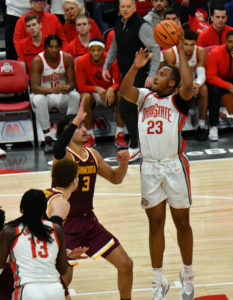Key Hampered By Shoulder Injury But Looks To End Season Strong

For much of the past month, Ohio State forward Zed Key has battled through a shoulder sprain — which he sustained during the Buckeyes’ 71-69 loss to Purdue on Jan. 5 — while trying to help the Buckeyes out of a rut, in which they’ve lost 11 of their last 12 games.
In each of Ohio State’s last two games, Key was forced to exit the floor briefly after re-aggravating the injury, but ultimately returned and finished out both contests. Although the threat of further injuring his shoulder looms, Key said he’s doing everything he can to power through the pain and close out the season.
“It affects me a little bit because, obviously, it’s my shoulder so I use it in the post and to rebound,” Key said. “I’ve been pushing through it every day. I’m continuing to practice and get better, and getting the team better.”
Key measured his pain as a six out of 10 while noting that he isn’t in pain at all times but it flares up in reaction to certain movements. Despite being hampered by pain, Key said he’s put no thought toward shutting it down prior to the conclusion of the season while adding that he’s still trying to do whatever is needed to help the team win.
“It’s not excruciating, but it lets you know that it’s there,” Key said. “If you move certain ways, it’s going to let you know that it’s there.”
Key has seen his production dwindle since sustaining the injury against the Boilermakers. Prior to the Purdue game, Key averaged 13.4 points on 63.5 percent shooting while pulling down 8.4 rebounds per contest. After missing just one game due to the injury, Key has produced 9.3 points per game while shooting 45.0 percent across Ohio State’s last eight games.
One potential cause of the noted decline in production could be the restrictive brace that Key has been required to wear since sustaining the injury. Head coach Chris Holtmann noted that the brace has impacted Key’s range of motion and ability to breathe, which Key echoed on Tuesday.
“I have to wear it, so I’m used to it now. I’ve been wearing it in practice, and just trying to get used to as much (as I can),” Key said. “It does affect my range of motion and breathing since it comes across the chest and it’s tight.”
Alongside the physical limitations provided by the injury, Key said he’s also been mentally impacted by it, pointing to the noted decline in production as a reason.
“It’s tough because you feel the pain and you want to go out there and be pain-free and play like how I know I can play and how I was playing at the beginning of the year,” Key said. “I’m staying locked in, staying locked in for the guys. Even on the bench, I’m just trying to spread energy.”